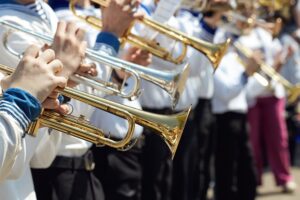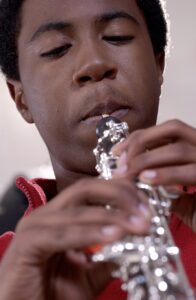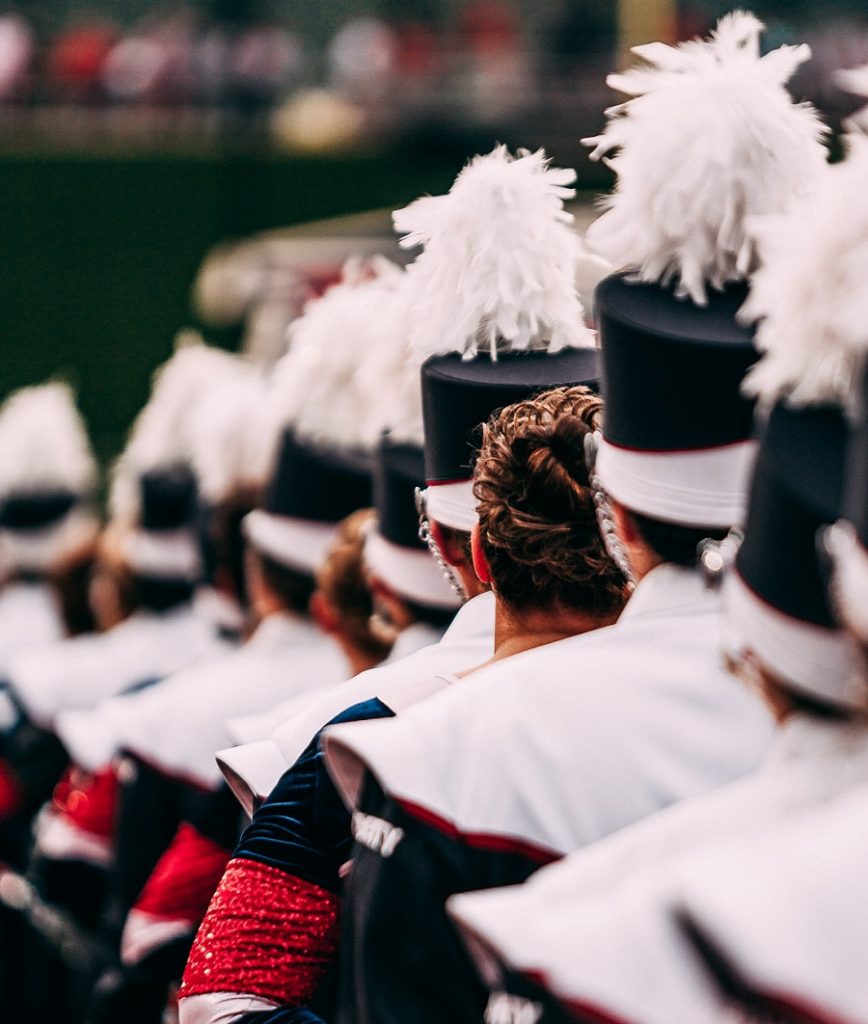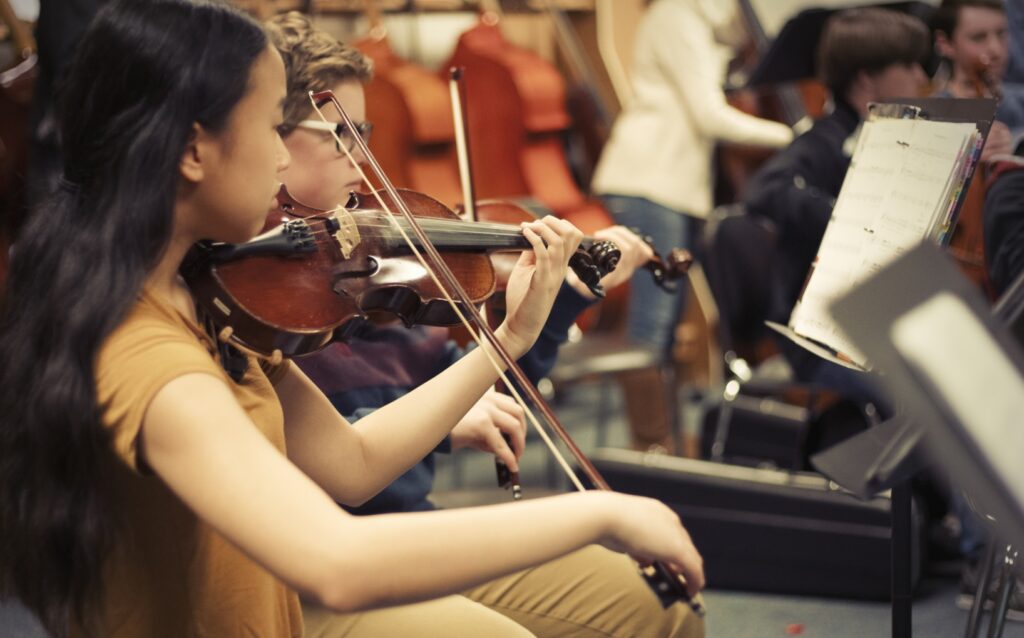Tagged Under:
Concert Chairs to Marching Squares
Try these 8 tips to help students switch instruments.
Have you ever gone to a musical or play, and read in the playbill that “tonight, the role of Mr. Brooks will be performed by another actor”? An understudy or another performer comes in to save the day when the star is unable to make the performance. They are just as professional, just as talented, and the show goes off without a hitch.
What about our situations with bands? We can do the same thing in band, just with a little more planning.
Why Switch?
“And tonight, the role of marching mellophone will be performed by flute one.”
We may promote a switch in instruments for students for many reasons. For example, some students may be stronger on another instrument, we may not have enough instruments in one area, etc.
I’m always about practicality, so if we think about switching instruments to help outdoor ensembles out, our reasons become pretty simple: compositions and volume.
- Compositions: We should switch some students to different instruments to perform musical arrangements for an outside venue (football field, stadium, town square, etc.)
- Volume: We want to think about projection. In other words, we want the band to be heard outside
In short, we want to be able to perform the written compositions as close to the intentions of the composer, and we want the kids to be heard outside.
How To Switch
I won’t go into a whole lot of methodology of how to select students to switch instruments or the proper methods, etc. There is a lot of information out there about this. Search the Yamaha Education blog for more or attend sessions at your state’s MEA.
However, here are eight tips to help you.
Tip 1: Consider Your Ensembles and Program Structure
For our purposes, let’s say that your band program consists of the following:
- Concert ensemble (also called symphonic band, wind ensemble, wind symphony, etc.)
- Marching band
- Jazz band
- Pep band
If I have an extracurricular marching band, I would consider my concert ensemble instrument first, and then I would focus on making my marching band instrumentation focused on projection (sorry, flutes, this is why we see a lot of flute players switch to different instruments or color guard).
However, if my marching band is curricular and is the focus of my program during most of the first semester, then I would have to be practical and think of the marching instrumentation first.
You know your program best!
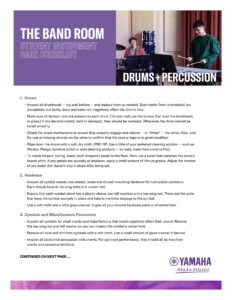
Download this Yamaha Drums and Percussion Care Checklist for Students now!
Tip 2: Consider Your Music/Arrangements
Your music selections can really help you determine where your instrument need is. If you are performing some marching arrangements for a show band or collegiate style band, you’ll find that most of the melody is written for trumpets, clarinets and flutes. If I’m lacking in trumpets, I may ask some flute players to consider taking up trumpet for marching band as it will help project the sound a little more.
We also want to consider the difficulty of the music. If you have a lot of students who are playing different instruments for an ensemble, consider programming music a grade or half-grade below what you normally program. You can also adapt some parts if necessary, provided you aren’t changing the overall piece.
Tip 3: Have a Set of Beginner Books
Find a set of beginning books and videos and stick with these. We typically use the books the students are already familiar with, such as Essential Elements. Also look at The Yamaha Advantage and the Hal Leonard Methods series. The students and I read the embouchure and instrument carriage information together as we go through one of these beginning books.
Videos: I am a fan of the Bravo Wind Training Series. There is a DVD for every instrument, and these DVDs/videos have been great resources for students on how to create a professional tone.
Tip 4: Have Some Instruments Available
“Hey, Bobby, can you switch to trombone?”
“Yes, I’d love to!”
“Great, that will be fifty bucks a month for the rental!”
If you are asking (or voluntelling) some kids to switch instruments, try to have an instrument for them to play. If there is a rental fee, consider waiving this fee. It can be difficult to say, “I really need this from you, and now you have to pay more!”

Tip 5: Give Student an Initial Lesson
The student switching to a new instrument should have an initial lesson with either the band director or a trusted teacher in your area. This can help get the student started with the right habits and routines, and it allow you to address any concerns.
You may not have the time or resources to continue providing individual lessons, but there is another way…

Tip 6: Use Your Teaching Assistants
I am the only director in my program. Yet, I have over 100 teaching assistants.
Don’t be afraid to have some of your stronger players work with someone who is switching an instrument. I often find that students enjoy this work, do a good job and even end up forming some new friendships and bonds.
I mention above that the student switching instruments should have an initial lesson with the band director or lesson teacher. Consider having any student helpers sit in on this lesson as well so everyone can be on the same page.
Tip 7: Be Careful of Too Much Too Soon
Often students learning a new instrument can fly through a beginning book. However, it is on the teachers to ensure that they are developing good habits. We do constant reinforcement of instrument position, embouchure development and making a quality tone. Some students want to rush to perform similar music that they perform on their primary instrument. There is no rush, and a quality tone will trump technical facility.
Tip 8: Work On Including Students in the Large Ensemble
When a student begins a new instrument in the fall during marching season, it can be difficult for them to feel like they can catch up to play with the ensemble. We work with these students as much as we can to make them feel comfortable. If the student can only play a portion of the marching show but is showing signs of progress, we do what we can to get them on the field as soon as possible.
We often find, not only with new performers, but even younger students, that proximity helps. A lesser-musically-skilled student between two strong musicians will often progress very quickly.

Plan Ahead: Use Jazz Band and Chamber Ensembles
My best personal method to switch instruments for outdoor ensembles? The jazz band.
If you have a jazz program or chamber group that meets in the spring, this can be a perfect example of how all musical groups can work in tandem. Besides being a great educational opportunity for the music, the jazz band can be an incredible tool to help students learn a new instrument.
Many of our flute and clarinet players perform on saxophone, trumpet and trombone in the jazz band. We perform music that is challenging enough for the ensemble but also meets the students where they are. By the end of the school year, these students can then naturally transition into performing this instrument for marching band, and the added plus is that we often need more trumpets, saxes and trombones in our outdoor performance.
Another option is to create some lab-based group. For example, you may run a jazz band that is auditioned, but then you would have a second group called jazz lab. This group would be open to anyone, but students who are in the auditioned jazz group must play a secondary instrument to be in jazz lab. This may fit in line better with a program that has a fairly competitive or high-tier jazz program.
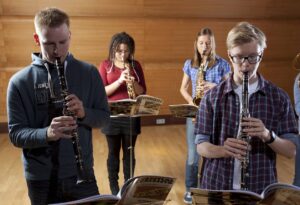
Debunking Myths
I hear a lot of myths ¬about switching instruments. Below are the four I hear the most — and they are simply not true!
- Myth 1: This will screw up their embouchure! I often hear this, but I’ve never met a kid who got worse when they started to play another instrument. Sure, there’s a transition period if they are going back and forth between clarinet and trombone (which can be a difficult switch to pull off due to the embouchure change), but I don’t recall seeing any permanent or even short-term damage.
- Myth 2: You need to stick to one instrument to actually get good at something! This depends. Is the student looking at a career in music teaching or performance? Then I may say to stick to one instrument and get really good on that. This helps the student focus more on their audition, helps them build resiliency, and makes sure they are in it for the long haul. But most students? I think this depends on their goals. We typically have a handful of kids who just want to learn every instrument imaginable and several who really focus on their primary instrument and maybe one additional instrument in pep, jazz or marching.
- Myth 3: Now they’ll just want to switch instruments all the time. Maybe, maybe not. But it’s important that the director has a system in place, and that they are comfortable with saying yes or no. We always have an abundance of percussionists, so students who want to switch to this do get a pretty clear “no.” But we, of course, have other options!
- Myth 4: If the kids play jazz or mariachi, it’s going to screw up their tone or embouchure! Again, there is a transition period sometimes, but we have many students involved in mariachi and jazz, and they have become much stronger members of our concert and marching bands. Plus, they really enjoy being a part of these ensembles, and that’s not a bad thing at all for music teachers to consider. If you notice any difference of tone or style, this is yet another opportunity to teach! Plus, wouldn’t it be great if our kids could perform in a variety of styles?
Top photo by Shutterstock/Ex-Artist










